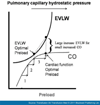The role for invasive monitoring in acute lung injury
- PMID: 23934719
- PMCID: PMC4216708
- DOI: 10.1055/s-0033-1351127
The role for invasive monitoring in acute lung injury
Abstract
Because acute lung injury (ALI) may arise from diverse and heterogeneous clinical insults, monitoring strategies for patients with ALI are heterogeneous as well. This review divides the monitoring strategies for ALI into three distinct phases. The "at-risk phase" is the period in which patients are at risk for ALI, and interventions may be applied to minimize or eliminate this risk. The "ALI phase" is the period during which ALI has occurred and requires attentive clinical management. The "resolution phase" is the period defined by resolution of ALI and successful discontinuation of mechanical ventilation. These phases are arbitrary, but they provide a useful framework for discussing the temporal changes in patient condition and monitoring goals in ALI.Invasive hemodynamic monitoring has specific roles in each phase of therapy for patients with ALI: pre-ALI, peri-ALI, and post-ALI. The primary goals are to optimize fluid resuscitation to prevent organ dysfunction, including ALI, and if ALI occurs to additional optimize fluid balance vis-à-vis the lung. By judicious application of invasive hemodynamic monitoring, particularly in its more modern iterations, clinicians can optimize the ebb and flow phases common to critically ill patients. This is vitally important given our current and growing understanding of the relationship between fluid balance and important clinical outcomes, multiple organ dysfunction syndrome, and mortality.
Thieme Medical Publishers 333 Seventh Avenue, New York, NY 10001, USA.
Conflict of interest statement
Figures



Similar articles
-
Noninvasive carbon dioxide monitoring in a porcine model of acute lung injury due to smoke inhalation and burns.Shock. 2013 Jun;39(6):495-500. doi: 10.1097/SHK.0b013e318292c331. Shock. 2013. PMID: 23572088
-
Early Identification of Acute Lung Injury in a Porcine Model of Hemorrhagic Shock.J Surg Res. 2020 Mar;247:453-460. doi: 10.1016/j.jss.2019.09.060. Epub 2019 Oct 24. J Surg Res. 2020. PMID: 31668606
-
[Mechanical ventilation and fluid management in acute lung injury. Effects on gas exchange and hemodynamics].Anaesthesist. 2009 Apr;58(4):410-4. doi: 10.1007/s00101-009-1525-0. Anaesthesist. 2009. PMID: 19326053 Review. German.
-
[Experts consensus on the management of the right heart function in critically ill patients].Zhonghua Nei Ke Za Zhi. 2017 Dec 1;56(12):962-973. doi: 10.3760/cma.j.issn.0578-1426.2017.12.017. Zhonghua Nei Ke Za Zhi. 2017. PMID: 29202543 Chinese.
-
Advances in monitoring and management of pediatric acute lung injury.Pediatr Clin North Am. 2013 Jun;60(3):621-39. doi: 10.1016/j.pcl.2013.02.015. Pediatr Clin North Am. 2013. PMID: 23639659 Review.
References
-
- Martin GS, Lewis CA. Fluid management in shock. Semin Respir Crit Care Med. 2004;25(6):683–693. - PubMed
-
- Martin GS, Bernard GR. Airway and lung dysfunction in sepsis. Intensive Care Med. 2001;27(Suppl 1):S63–S79. - PubMed
-
- Dellinger RP, Levy MM, Carlet JM, et al. Surviving Sepsis Campaign: international guidelines for management of severe sepsis and septic shock: 2008. Crit Care Med. 2008;36(1):296–327. - PubMed
-
- Rivers E, Nguyen B, Havstad S, et al. Early goal-directed therapy in the treatment of severe sepsis and septic shock. N Engl J Med. 2001;345(19):1368–1377. - PubMed
-
- Osman D, Ridel C, Ray P, et al. Cardiac filling pressures are not appropriate to predict hemodynamic response to volume challenge. Crit Care Med. 2007;35(1):64–68. - PubMed
Publication types
MeSH terms
Grants and funding
LinkOut - more resources
Full Text Sources
Other Literature Sources

